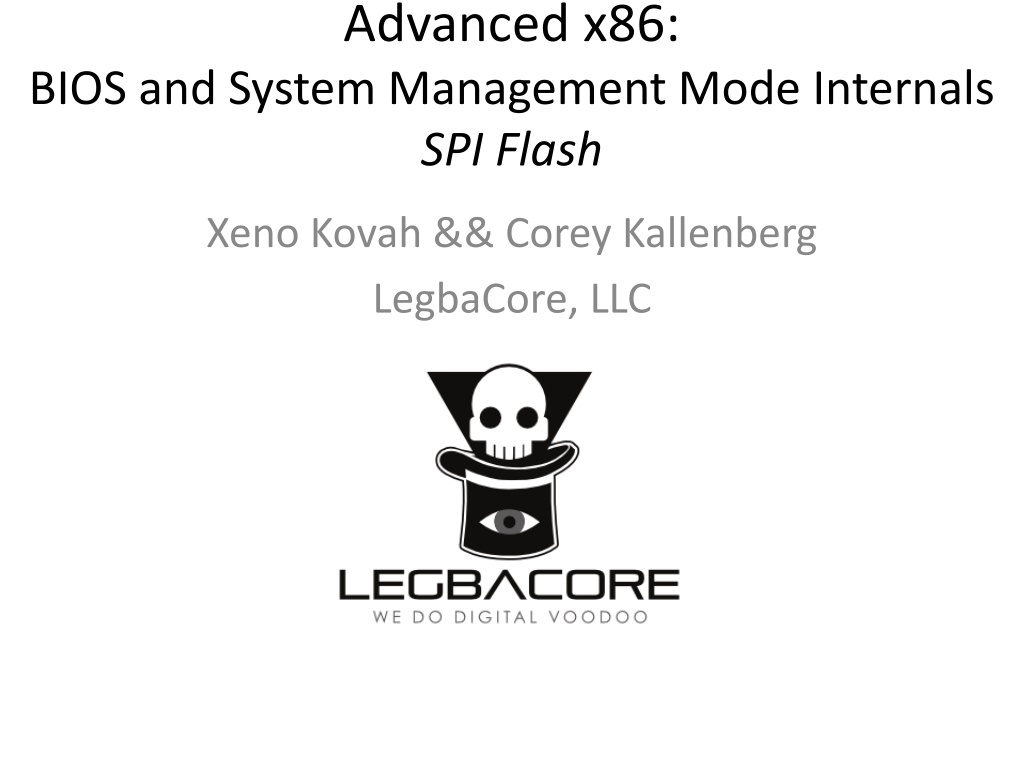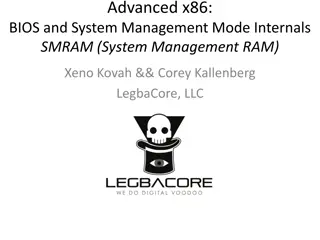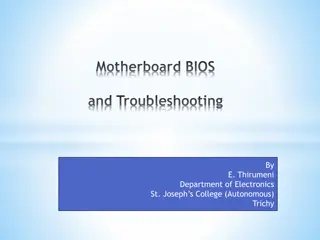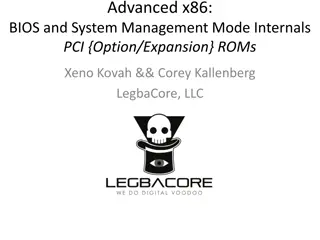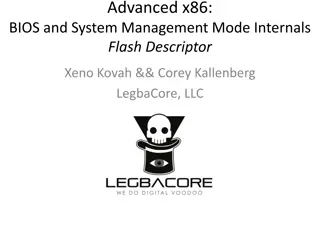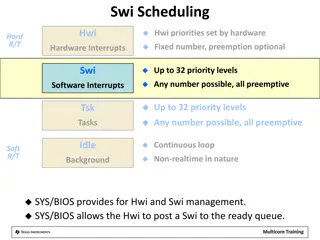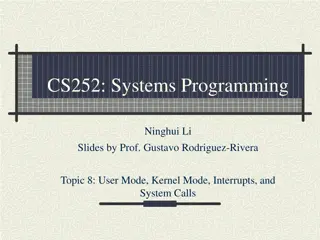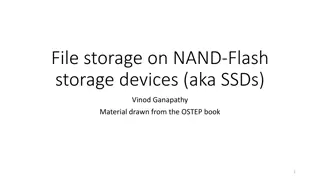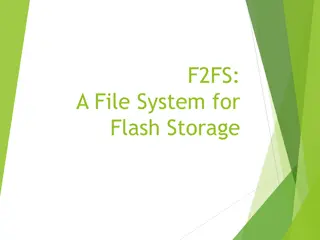BIOS Flash and System Management Mode Internals
Dive into the intricacies of BIOS flash and system management mode internals, exploring SPI flash technology, attacker persistence strategies, Copernicus vulnerability scanning results, BIOS flash locations, and boot BIOS flash configurations. Uncover the significance of hardware pins in determining BIOS boot destinations and the implications for system security.
Download Presentation

Please find below an Image/Link to download the presentation.
The content on the website is provided AS IS for your information and personal use only. It may not be sold, licensed, or shared on other websites without obtaining consent from the author.If you encounter any issues during the download, it is possible that the publisher has removed the file from their server.
You are allowed to download the files provided on this website for personal or commercial use, subject to the condition that they are used lawfully. All files are the property of their respective owners.
The content on the website is provided AS IS for your information and personal use only. It may not be sold, licensed, or shared on other websites without obtaining consent from the author.
E N D
Presentation Transcript
Advanced x86: BIOS and System Management Mode Internals SPI Flash Xeno Kovah && Corey Kallenberg LegbaCore, LLC
All materials are licensed under a Creative Commons Share Alike license. http://creativecommons.org/licenses/by-sa/3.0/ Attribution condition: You must indicate that derivative work "Is derived from John Butterworth & Xeno Kovah s Advanced Intel x86: BIOS and SMM class posted at http://opensecuritytraining.info/IntroBIOS.html 2
BIOS Flash Overview Everything we have talked about so far, although harmful to a system, isn t persistent unless you can write to the BIOS But one of the goals an attacker has in establishing a presence in the system is persistence To achieve persistence, the attacker will have to figure out a way to write to the BIOS flash so that upon every reboot, his presence is still there 3
Results of Copernicus checks We ve used Copernicus to scan all of MITRE, and some other organizations. Originally (in 2013) the data said about 35% of systems were vulnerable. Then we found more problems and it went up to 55% Then people patched and it went down to 35% Then we found more problems and it went up to 60% Then we found more problems and it went up to 85% And if the organizations had never patched, and we looked at our first data with our last knowledge? 99.95% vulnerable 4
BIOS Flash Location BIOS can reside in one of 3 locations: 1. Firmware Hub (FWH) Older technology and mostly out of scope for this class 2. SPI Flash Most likely location 3. PCI intended for debugging or recovering from a corrupted BIOS (not supported anymore on newer hardware) 5
Boot BIOS Flash Location The boot destination is decided by the configuration of the following pins on the ICH/PCH* Pins are sampled at power- up to determine location of BIOS Intended for static configuration PCI boot is intended only for debugging or recovering from corrupt BIOS (so not necessarily static) But since these are hardware pins, it s worth checking if PCI is set as the boot location, because you might have a physical hardware implant! * References to ICH/PCH mean applicable to both legacy and modern chipsets 6
Example: Find BIOS Boot Destination To programmatically find where your BIOS is configured to boot from, you can also view bits 11:10 in the General Control and Status Register (GCS) Located at memory- mapped offsets 3410- 3413h in the Chipset Configuration Registers Chipset Configuration Registers are mapped starting at the address held by RCBA you know, RCRB? :) 01b SPI (typo in datasheet) Verify GCS location on your datasheet if not using the class E6400. 7
Reminder: RCBA/RCRB You know the drill! The Root Complex Register Block (RCRB) decode range is located in the Root Complex Base Address (RCBA) register located in the LPC (D31:F0, offset F0-F3h) The root complex is PCI-Express related. It connects the processor and memory to the PCI Express devices. If you want to know more about the inner workings of PCI Express, there are a number of good sources, such as (Darmawan): http://resources.infosecinstitute.com/system-address-map- initialization-x86x64-architecture-part-2-pci-express-based-systems/ 8
Example: Find BIOS Boot Location Locate RCRB: Bit 0 is just an enable bit (the nibble this bit is in is still part of the address, but change it to 0) Here the RCRB begins at FED1_8000h The GCS register is located at in the chipset configuration registers. At RCRB + 3410h = FED1_B410h The root complex base address will differ on different systems. 9
Example: Find BIOS Boot Location GCS at FED1_B410h yields the following value on our lab system: 00C0_0440h Bits 11:10 are 01b which indicates that this BIOS boots from SPI But how can we trust what this says? We re not actually sampling the Controller s pins in this register Bits 11:10 10
Example: Change BIOS Access Destination Notice these bits are R/W? You can change the destination for BIOS accesses Likely this is to help the system recover from a corrupted BIOS But it could be certainly misused as well Note just to be clear: The bits in GCS alter accesses to the BIOS *only* after the BIOS has begun booting Chipset Configuration registers must be mapped to memory, etc. The functional straps are physical pins which cannot be altered and decide the BIOS Boot Location 11
Example: Change BIOS Access Destination Bring up a memory window and go to an address which shows the memory-mapped BIOS (like FFFF_FF80h which will show us the entry vector) You should see the BIOS in memory 12
Example: Change BIOS Access Destination Modify the GCS register to 00C00C40h, bits 11:10 are 11b now which point the device to the LPC On our lab system the LPC has no firmware BIOS so this translates to reads of all 1 s (0xFF) Your personal system may differ and you may actually see valid binary here. 13
Example: LOCK BIOS Access Destination Intel provides a way to lock down the destination of BIOS accesses When bit 0 in the General Control and Status Register (GCS) is set, bits 11:10 become Read-Only The BIOS should lock this down! 14
Example: Change BIOS Access Destination Set bits 11:10 in the GCS register back to their original values (01b for SPI)* Assert bit 1 in GCS, now GCS is 00C00441h Now find that bits 11:10 are fixed in place *Or leave them pointing to nothing, this is not permanent and nothing a reboot won t reset 15
A Word About This This only affects direct (memory) accesses to BIOS flash Programs (like Copernicus or Flashrom) that read directly from the BIOS flash using the SPI programming registers (for example) will still successfully read the BIOS binary from the chip 16
Firmware Hub (FWH) Provides register-based R/W protection for each code/data storage block Has hardware write-protect pins for the top boot block and the remaining code/data storage blocks Contains a Random Number Generator (RNG) More than one FWH device can be supported Operates at 33 MHz (synchronous to the PCI bus) Has a lot of pins compared to SPI Intel 82802AB/82802AC Firmware Hub (FWH) 17
Firmware Hub (FWH) Memory-mapped interface Programmable Erase, Read, Write commands Each block can be locked down to prevent Reads and/or Writes Firmware hubs are rare (at least in modern PC s) and we have never seen one Sample FWH datasheet: http://download.intel.com/d esign/chipsets/datashts/29 065804.pdf If you ever encounter a system with a firmware hub email me and tell me the make/model please Intel 82802AB/82802AC Firmware Hub (FWH) 18
Serial Peripheral Interface (SPI) Intel s ICH/PCH implements a SPI interface for the BIOS flash device Used as a replacement for the Firmware Hub (FWH) on LPC SPI is required in order to support the Management Engine (ME), Gigabit Ethernet (GbE), and others. Each SPI flash device can be up to 16 MB (224 bits) Typically 8 pins, can be 16 SPI controller can support 1 or 2 devices for 32 MB maximum addressable space Lower cost alternative (per Intel datasheet) Memory-mapped programming interface offset from RCRB (consult your datasheet for its exactly offset) *Based on datasheet information and that the Flash Address Register accepts addresses occupying bits 24:019
SPI Overview SPI protocol can support data rates up to 100 MHz Intel s implementation is configurable to operate at either 20 MHz or 33 MHz (or 50 MHz on the newer PCI Express systems), or 66MHz Intel abstracts most of the low-level SPI protocol from you SPI protocol is not a fixed standard Different chips will support different commands and so forth Intel defines a set of minimum requirements for a chip to support. Likely though each chip will support more than just that bare minimum So we ll be covering Intel s implementation and interface to SPI, not really the SPI protocol itself (they intertwine somewhat of course). 20
SPI Operating Modes Since I/O Controller Hub version 8, the SPI flash has been able to support 2 distinct operating modes: Non-Descriptor Mode (RIP, deceased 09) IT LIVES! (On embedded Intel Atom devices like MinnowBoard!) In ICH7 this is the only supported operating mode Descriptor Mode Since ICH8 (so ICH8, ICH9, ICH10, and PCH) For systems that have a Platform Controller Hub device (PCH), non-descriptor mode has been phased out and is no longer supported 21
Descriptor Mode Enables chipset features like: Integrated Gigabit Ethernet, Host processor for Gigabit Ethernet Software, Management Engine Provides support for two SPI flash chips Divides the SPI flash into regions Provides hardware enforced security restricting region access Chipset Soft Strap region provides the ability to use Flash NVM as an alternative to hardware pull-up/pull-down resistors for both ICH and PCH On reset, the controller hub reads the soft strap data out of the SPI flash Can be programmed (at a minimum) using the commands specified in the Intel ICH/PCH datasheet But each chip can support additional commands, not very standardized 22
Memory Mapping: Descriptor Mode 4GB All of the flash chip is mapped to high memory In Descriptor Mode, only the BIOS region of the flash is readable in memory All other regions return 0xFF on reads We'll get to the other regions in a bit BIOS Region Memory Flash Contents Flash contents that are viewable in Memory 23
Non-Descriptor Mode Best described by its lack of features (as compared to Descriptor mode) The entire flash is used for BIOS (this does not mean the BIOS will be larger) Security features available in Descriptor mode are not available in Non-Descriptor mode The BIOS/CPU can read/write to the flash without restriction Therefore there is also no support for Gb Ethernet, Management Engine, or chipset soft straps Interesting quote in Intel s ICH datasheet (10, in this case): [in Non-Descriptor Mode], Direct read and writes are not supported. Non-Descriptor Mode == !Descriptor Mode No longer a viable option on the newer PCH systems, since they require a valid flash descriptor 24
Memory Mapping: Non-Descriptor Mode 4GB 4GB size of flash (MB) In Non-Descriptor Mode the entire flash contents are visible in memory (more than just BIOS, if any more is present) If flash is < 16 MB and the FWH decoders are enabled in LPC, you will see the BIOS mapped repeatedly (think ribbons) at high memory A 4MB BIOS is mapped 4 times in the high 16 MB of memory space A flash device in descriptor mode that has its descriptor signature corrupted will be viewable in memory in its entirety But the descriptor signature is protected, so that would require physical flash access to corrupt 4GB 16 MB Entire Flash Memory Flash Contents Flash Contents Readable in Memory 25
Non-Descriptor Mode Memory Mapping Example of 4 MB device in non- descriptor mode mapped to high 16MB of memory Invalid Flash Descriptor 0FF0A55Bh instead of 0FF0A55Ah 26
Why is some of the chip visible in memory in one mode but not the other? Has to do with the type of flash access as well as permissions to read that memory: There is an SPI rule that states: Every SPI Master has direct read access to it s own region only Direct Access refers to memory reads in mapped memory Thus the BIOS Master can read the BIOS region in memory (mapped to high mem at 4 GB) In Descriptor mode, the SPI flash is divided into regions BIOS region, Flash Descriptor, etc. (we ll cover in more detail soon) Therefore, in Descriptor Mode, only the BIOS region can be seen in high mapped-memory In Non-Descriptor mode, there is no concept of regions It s just the BIOS So therefore, the entire BIOS (entire flash) can be seen in memory when the SPI flash is in Non-Descriptor mode 27
Flash Accesses: Direct vs. Register Direct Access This applies to memory accesses (mapped to high-memory) Masters are allowed to read only their own region CPU/BIOS can read the BIOS region Management Engine can read only the ME region GbE controller can read the GbE region (GbE software must use the programming registers) Register Access Access a region by programming the base address registers Register accesses are not allowed to cross a 4 KB aligned boundary Cannot execute a command that may extend across to a second SPI flash (if present) Software must know the SPI flash linear address it is trying to read 28
